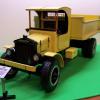-
Posts
2,782 -
Joined
-
Last visited
Content Type
Profiles
Forums
Events
Gallery
Everything posted by Chariots of Fire
-

Polish, clear coat Plastic bodies?
Chariots of Fire replied to Oldmopars's topic in General Automotive Talk (Trucks and Cars)
Why clear coat it? Use some Novus plastic scratch remover #2 and the polish and you will have a great finish. -
I didn't know Harry personally but did a small decal project for him a while back. So to have been part of his life in a small way makes it special. It's always sad when someone you know close up or from far away is suddenly taken. We can all take comfort, however, in knowing that God answers prayer sometimes in ways that we do not understand. His ways are not our ways and we only see those things "through a glass darkly". In all things pray without ceasing regardless of the outcome.
-

TAT Brockway 361
Chariots of Fire replied to gotnitro?'s topic in Model Trucks: Big Rigs and Heavy Equipment
Nice job! The yellow and black paint scheme is just right! Love the heavy weight stuff! -

gmc crackerbox
Chariots of Fire replied to jacobus's topic in Truck Aftermarket / Resin / 3D Printed
Jeff will have to answer that but he is a pretty knowledgeable builder of GMC rigs. PS You should see his 1970's Chevy Titan! -

The Road Weary Roadway Ford
Chariots of Fire replied to Tyler62990's topic in Model Trucks: Big Rigs and Heavy Equipment
Agree with what everyone else has said. Nice job. I have an issue with rear view mirrors also. The mounting brackets are always to thick and aren't made so that the mirrors look right. Now I make a lot of my mirror brackets from long straight pins or other materials that I can solder together. Then the ends of the mirrors are drilled out for the new brackets to go in. Makes a big difference in the overall appearance. -

2016 Builds...Let's See 'Em....
Chariots of Fire replied to kilrathy10's topic in Model Trucks: Big Rigs and Heavy Equipment
My 2016 builds (Actually I started the first one in 2016, finished this year) [/URL -

TAT International R190 tanker
Chariots of Fire replied to landman's topic in Model Trucks: Big Rigs and Heavy Equipment
What they said! Great job! -

TAT International R190 tanker
Chariots of Fire replied to landman's topic in WIP: Model Trucks: Big Rigs and Heavy Equipment
You seem to have got pretty good coverage over the red plastic. Not an easy thing to do. -

TAT International R190 tanker
Chariots of Fire replied to landman's topic in WIP: Model Trucks: Big Rigs and Heavy Equipment
Just a question. Did you use decal paper that is made for ink jet printers? I think it works without running although I've never tried it since I use an ALPS. -

1988 Ford L-9000 Aeromax
Chariots of Fire replied to Arnd's topic in WIP: Model Trucks: Big Rigs and Heavy Equipment
Working the old stuff can be more fun than building something new, especially if it is a unique rig! Nice combination of parts from different sources. -

1954 Maxim 750 Pumper
Chariots of Fire replied to Chariots of Fire's topic in WIP: Model Trucks: Big Rigs and Heavy Equipment
We're closing in on the last details of this build. Except for completing the hose load on the right side and making up a cover and small hose load over the walkway to the rear of the cab we are done. So here are some photos of the building progress to date. That little gadget in front in the first photo is the "Official Door Opener". Instead of using a finger or tweezers to open the doors and taking a chance on marring the paint you can use the opener. I decided to fancy it up a bit with an eagle on top and some gold leaf trim. -

TAT International R190 tanker
Chariots of Fire replied to landman's topic in WIP: Model Trucks: Big Rigs and Heavy Equipment
The latch also attaches to the cover itself so that when you lift the latch the cover opens with it. -

1954 Maxim 750 Pumper
Chariots of Fire replied to Chariots of Fire's topic in WIP: Model Trucks: Big Rigs and Heavy Equipment
We are continuing to add details. This time the windshield wipers are done, rear handrails are on, ladder brackets and ladders are in place. Also the extinguisher and axe have been mounted. The cross mounted railings at the rear are temporarily in place. It will be much easier to load the hose and covers with them out of the way. Once all that is done the railings will be mounted permanently. -

TAT International R190 tanker
Chariots of Fire replied to landman's topic in WIP: Model Trucks: Big Rigs and Heavy Equipment
I like your shop! Agreed! It looks like the crew just left for lunch and will be mounting the bumper when they come back! That's cool! -

TAT International R190 tanker
Chariots of Fire replied to landman's topic in WIP: Model Trucks: Big Rigs and Heavy Equipment
Hey, Pat! It's the widgets that count! Details like what you are doing go a long way toward making a model a cut above the rest. Keep up the good work! -

1954 Maxim 750 Pumper
Chariots of Fire replied to Chariots of Fire's topic in WIP: Model Trucks: Big Rigs and Heavy Equipment
One more photo. Yesterday I worked on making up a siren and mounting for the left front fender. It is turned aluminum with a photoetch mesh around the middle. I drilled out the front, fillled it with clear epoxy and then painted it with Tamiya clear red for a lens. The aluminum polishes up quite nicely.
